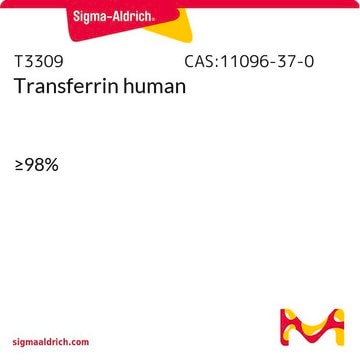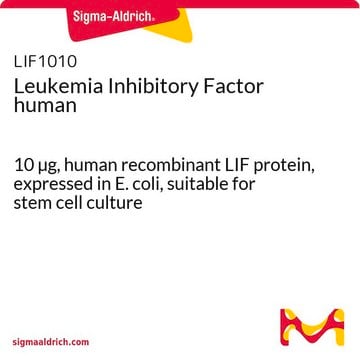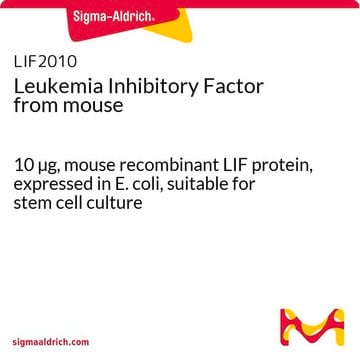L9545
Leukemia Inhibitory Factor human, animal component free
recombinant, expressed in rice, 500 μg/mL
Synonyme(s) :
Leukemia Inhibitory Factor human, LIF, rLIF
About This Item
Produits recommandés
Produit recombinant
expressed in rice
Pureté
>95% (SDS-PAGE)
Puissance
>1 x 108 units/mg ED<sub>50</sub>
Concentration
500 μg/mL
Technique(s)
cell culture | mammalian: suitable
Impuretés
<0.05 EU/μg endotoxin
Numéro d'accès UniProt
Conditions d'expédition
dry ice
Température de stockage
−70°C
Informations sur le gène
human ... LIF(3976)
Vous recherchez des produits similaires ? Visite Guide de comparaison des produits
Actions biochimiques/physiologiques
Forme physique
Informations légales
Code de la classe de stockage
10 - Combustible liquids
Point d'éclair (°F)
Not applicable
Point d'éclair (°C)
Not applicable
Certificats d'analyse (COA)
Recherchez un Certificats d'analyse (COA) en saisissant le numéro de lot du produit. Les numéros de lot figurent sur l'étiquette du produit après les mots "Lot" ou "Batch".
Déjà en possession de ce produit ?
Retrouvez la documentation relative aux produits que vous avez récemment achetés dans la Bibliothèque de documents.
Les clients ont également consulté
Articles
Leukemia Inhibitory Factor (LIF) is a stem cell growth factor used for the in vitro culture of pluripotent mouse embryonic stem cells (ES cells).
Notre équipe de scientifiques dispose d'une expérience dans tous les secteurs de la recherche, notamment en sciences de la vie, science des matériaux, synthèse chimique, chromatographie, analyse et dans de nombreux autres domaines..
Contacter notre Service technique











